Class 10 - Mathematics
Surface Areas and Volumes Exercise - Exercise 13.5
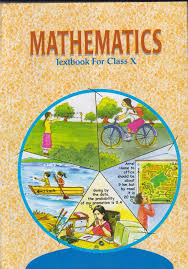
Top Block 1
Exercise 13.5
Exercise 13.5
Question : 1:A copper wire, 3 mm in diameter, is wound about a cylinder whose length is 12 cm, and diameter 10 cm,
so as to cover the curved surface of the cylinder.
Find the length and mass of the wire, assuming the density of copper to be 8.88 g per cm3.
Answer :
It can be observed that 1 round of wire will cover 3 mm height of cylinder.
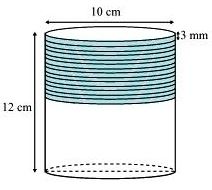
= 12/0.3 [3 mm = 3/10 cm = 0.3 cm]
= (12 * 10)/3
= 120/3
= 40 rounds
Length of wire required in 1 round = Circumference of base of cylinder
= 2πr = 2π * 5 = 10π
Length of wire in 40 rounds = 40 * 10π
= 40 * 10 * 22/7
= 8800/7
= 1257.14 cm
= 12.57 m
Radius of wire = 0.3/2 = 0.15 cm
Volume of wire = Area of cross-section of wire * Length of wire
= π(0.15)2 * 1257.14
= 88.898 cm
Mass = Volume * Density
= 88.898 * 8.88
= 789.41 gm
Question : 2:A right triangle, whose sides are 3 cm and 4 cm (other than hypotenuse) is made to revolve about its hypotenuse.
Find the volume and surface area of the double cone so formed. (Choose value of π as found appropriate.)
Answer :
The double cone so formed by revolving this right-angled triangle ABC about its hypotenuse as
shown in the figure.
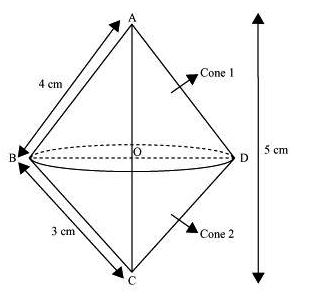
Mddle block 1
Area of ΔABC = 1/2 * AB * AC
⇒ 1/2 * AC * OB = 1/2 * 4 * 3
⇒ 5 * OB = 4 * 3
⇒ OB = 12/5
⇒ OB = 2.4 cm
Volume of double cone = Volume of cone 1 + Volume of cone 2
= πr2 h1/3 + πr2 h2/3
= πr2 (h1 + h2)/3
= πr2 (OA + OC)/3
= {3.14 * (2.4)2 * 5}/3
= 30.14 cm3
Surface area of double cone = Surface area of cone 1 + Surface area of cone 2
= πrl1 + πrl2
= πr(4 + 3)
= 3.14 * 2.4 * 7
= 52.75 cm2
Question : 3:A cistern, internally measuring 150 cm × 120 cm × 110 cm, has 129600 cm3 of water in it.
Porous bricks are placed in the water until the cistern is full to the brim.
Each brick absorbs one-seventeenth of its own volume of water. How many bricks can be put in without overflowing the water,
each brick being 22.5 cm × 7.5 cm × 6.5 cm?
Answer :
Volume of cistern = 150 * 120 * 110 = 1980000 cm3
Volume to be filled in cistern = 1980000 – 129600 = 1850400 cm3
Let n numbers of porous bricks were placed in the cistern.
Volume of n bricks = n * 22.5 * 7.5 * 6.5 = 1096.875n
As each brick absorbs one-seventeenth of its volume, therefore, volume absorbed by these
bricks = n(1096.875)/17
Now, 1850400 + n(1096.875)/17 = 1096.875 * n
⇒ 1096.875 * n – n(1096.875)/17 = 1850400
⇒ 1096.875(n – n/17) = 1850400
⇒ 1096.875 * 16n/17 = 1850400
⇒ n = (1850400 * 17)/( 1096.875 * 16)
⇒ n = 1792.41
Therefore, 1792 bricks were placed in the cistern.
Question : 4:In one fortnight of a given month, there was a rainfall of 10 cm in a river valley.
If the area of the valley is 97280 km2, show that the total rainfall was approximately equivalent to the addition to the
normal water of three rivers each 1072 km long, 75 m wide and 3 m deep.
Answer :
Area of the valley = 7280 km
If there was a rainfall of 10 cm in the valley then amount of rainfall in the valley
= Area of the valley * 10 cm
Amount of rainfall in the valley = 7280 km2 * 10 cm
= 7280 * (1000 m)2 * 10/100 m
= 7280 * 105 m3
= 7.28 * 108 m3
Length of each river, l = 1072 km = 1072 * 1000 m = 1072000 m
Breadth of each river, b = 75 m
Depth of each river, h = 3 m
Volume of each river = l * b * h
= 1072000 * 75 * 3
= 2.412 * 108 m3
Volume of three such rivers = 3 * Volume of each river
= 3 * 2.412 * 108 m3
= 7.236 * 108 m3
Hence, total rainfall is approximately same as the volume of the three rivers.
Question : 5: An oil funnel made of tin sheet consists of a 10 cm long cylindrical portion attached to a frustum of a cone.
If the total height is 22 cm, diameter of the cylindrical portion
is 8 cm and the diameter of the top of the funnel is 18 cm, find the area of the tin sheet required to make the funnel (see Fig. 13.25).

Answer :
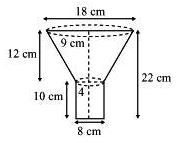
Radius (r2) of lower circular end of frustum part = Radius of circular end of cylindrical part
= 8/2 = 4 cm
Height (h1) of frustum part = 22 − 10 = 12 cm
Height (h2) of cylindrical part = 10 cm
Slant height (l) of frustum part = √{(r1 – r2)2 + h2}
= √{(9 – 4)2 + 122}
= √(25 + 144)
= √169
= 13
Area of tin sheet required = CSA of frustum part + CSA of cylindrical part
= π(r1 + r2)l + 2πr2 h2
= 22/7 * (9 + 4) * 13 + 2 * 22/7 * 4 * 10
= 22(169 + 80)/7
= (22 * 249)/7
= 5478/7
= 782 4/7 cm2
Question : 6:Derive the formula for the curved surface area and total surface area of the frustum of a cone, given to you in Section 13.5,
using the symbols as explained.
Answer :
Let ABC be a cone. A frustum DECB is cut by a plane parallel to its base. Let r1 and r2 be the
radii of the ends of the frustum of the cone and h be the height of the frustum of the cone.
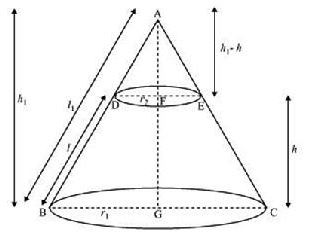
So, ΔABG ∼ΔADF
DF/BG = AF/AG = AD/AB
⇒ r2/r1 = (h1 – h)/h1 = (l1 – l)/l1
⇒ r2/r1 = 1 – h/h1 = 1 – l/l1
⇒ r2/r1 = 1 – l/l1
⇒ l/l1 = 1 – r2/r1
⇒ l/l1 = (r1 – r2)/r1
⇒ l1/l = r1/(r1 – r2)
⇒ l1 = l * r1/(r1 – r2)
CSA of frustum DECB = CSA of cone ABC − CSA cone ADE
= πr1 l1 – πr2(l1 – l)
= πr1 { l * r1/(r1 – r2)} – πr2{ l * r1/(r1 – r2) – l}
= πr12 l/(r1 – r2)} – πr2 {(r1 l – r1 l + r2 l )/(r1 – r2)}
= πr12 l/(r1 – r2)} – πr22 l/(r1 – r2)}
= πl(r12 – r2 2)/(r1 – r2)
CSA of frustum = π(r1 + r2)l
Total surface area of frustum = CSA of frustum + Area of upper circular end + Area of upper
circular end
= π(r1 + r2)l + πr22 + πr12
= π[(r1 + r2)l + r22 + r12]
Question : 7:Derive the formula for the volume of the frustum of a cone, given to you in Section 13.5, using the symbols as explained.
Answer :
Let ABC be a cone. A frustum DECB is cut by a plane parallel to its base. Let r1 and r2 be the
radii of the ends of the frustum of the cone and h be the height of the frustum of the cone.
In ΔABG and ΔADF, DF||BG
So, ΔABG ∼ΔADF
DF/BG = AF/AG = AD/AB
⇒ r2/r1 = (h1 – h)/h1 = (l1 – l)/l1
⇒ r2/r1 = 1 – h/h1 = 1 – l/l1
⇒ r2/r1 = 1 – h/h1
⇒ h/h1 = 1 – r2/r1
⇒ l/l1 = (r1 – r2)/r1
⇒ h1/h = r1/(r1 – r2)
⇒ h1 = h * r1/(r1 – r2)
Volume of frustum of cone = Volume of cone ABC − Volume of cone ADE
= πr12 h1/3 – π r22 (h1 – h)/3
= 1/3 * π[r12 h1 – r22 (h1 – h)]
= 1/3 * π[r12 * h * r1/(r1 – r2) – r22 { h * r1/(r1 – r2) – h}]
= 1/3 * π[hr13/(r1 – r2) – r22 {(hr1 – hr1 + hr2)/ (r1 – r2)]
= 1/3 * π[hr13/(r1 – r2) – hr23/ (r1 – r2)]
= h/3 * π[(r13 – r23)/(r1 – r2)]
= h/3 * π[{(r1 – r2) r12 + r22 + r1 r2)}/(r1 – r2)]
= πh[r12 + r22 + r1 r2]/3

